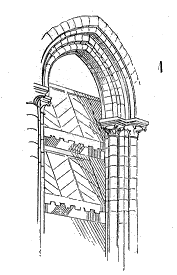Sound arcade
Sound arcades , also known as sound windows or sound hatches , are round or pointed arched arcade openings in the walls of historical bell towers at the level of the bell room (s), in which the bells are suspended swinging freely on bell stalls. The task of the sound arcades is to allow the sound generated by the bells to reach the open air in all directions largely unhindered.
description
The openings of sound arcades can usually be recognized by the so-called sound lamellas , which primarily have the task of protecting the bell chamber from driving rain, but at the same time only marginally narrowing the sound openings. These are flat lamellas made of wood, which were often slated in the past, but are now mostly coated on all sides with corrosion-resistant sheet metal or even made entirely of metal. They are clamped horizontally between the side reveals of the arcades at the same distance from one another and are bevelled towards the outside. It is not uncommon for openings to remain without sound fins.
Often there are also pairs of sound arcades (twin arcades) on mostly all sides of a church tower.
Medieval sound arcades usually have profiled walls made of ashlar and in Romanesque architecture are often flanked or divided by columns with capitals and bases and covered by archivolts . In the Gothic , the tapering arch area developed into an artfully formed openwork tracery ornament , as was otherwise also the case with windows.
Image examples
Notre-Dame church in Antigny , bell tower from the southwest
Church of St-André in Saint-André-de-Bâgé , choir head, transept, crossing tower from the southeast
Notre-Dame-du-Port de Clermont-Ferrand , crossing tower from the east
St-Junien , westwork and facade from the west
Dijon Cathedral , westwork from the west
Tower of St. Zeno in Bad Reichenhall , after the tower was raised, the lower sound arcades were closed
special cases
There are also differently designed sound openings, for example in the shape of a square or a round hole, which can then no longer be called an 'arcade'.






